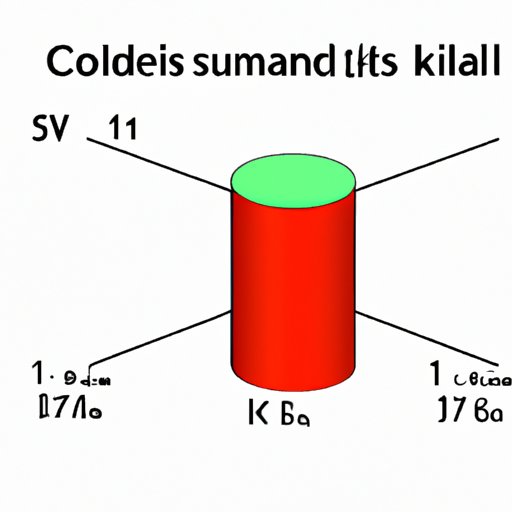
I. Introduction
Calculating volume is an essential skill in a variety of fields. Whether you’re an engineer, physicist, or math enthusiast, being able to calculate the volume of a cylinder accurately is crucial. In this article, we’ll explore how to calculate volume in a cylinder, provide a step-by-step guide, and offer tips to help you master this skill.
II. “Mastering the Art of Volume Calculation: A Guide to Calculating Cylinder Volume”
Before diving into the nitty-gritty of calculating cylinder volume, it’s essential to understand why it’s an important skill. Being able to calculate volume in a cylinder accurately helps in various industries, including construction, science, and engineering. It’s vital for engineers to calculate the volume of the liquid they need to store in a cylinder tank accurately, while scientists need to understand how to calculate the volume of gases.
Mastering the art of cylinder volume calculation can also boost your math skills. It improves your ability to solve complex mathematical problems, thereby sharpening your analytical and critical thinking abilities.
III. “Crunching the Numbers: How to Calculate Volume in a Cylinder”
The formula for calculating the volume of a cylinder is V = πr2h.
V represents the volume, r denotes the radius, and h represents the height of the cylinder. π is a constant value of 3.14 that helps calculate the volume of circular objects.
When using this formula, many people make mistakes, such as using the diameter instead of the radius. It’s essential to understand the meaning of each term to prevent these errors.
IV. “Cylinder Volume Calculation: Step-by-Step Guide for Beginners”
If the formula for calculating volume in a cylinder seems intimidating, don’t worry, this step-by-step guide will make it easy.
To calculate the volume of a cylinder, follow these simple steps:
- Measure the radius (r) of the cylinder
- Measure the height (h) of the cylinder
- Square the radius (r) by multiplying it by itself
- Multiply the squared radius by π
- Multiply the result obtained in step 4 by the height (h) of the cylinder
An example: Imagine you have a cylinder with a height of 10 meters and a radius of 5 meters. How do you calculate the volume of this cylinder?
- Measure the radius (r) of the cylinder: 5 m
- Measure the height (h) of the cylinder: 10 m
- Square the radius (r) by multiplying it by itself: 5 x 5 = 25
- Multiply the squared radius by π: 25 x 3.14 = 78.5
- Multiply the result obtained in step 4 by the height (h) of the cylinder: 78.5 x 10 = 785
Therefore, the volume of the cylinder is 785 cubic meters.

V. “Revving Up Your Math Skills: Calculating the Volume of a Cylinder”
If you’re someone who struggles with math, don’t worry. With consistent practice and a positive attitude, anyone can improve their math skills. To strengthen your math abilities, consider using educational resources such as math textbooks, videos, and online courses. Additionally, finding a study group or hiring a tutor can help you develop your skills even further.
VI. “No More Confusion: Simplifying the Calculation of Cylinder Volume”
If you still feel confused about calculating cylinder volume, don’t worry. Try exploring different explanations of the formula to find one that works best for you. One such explanation is to think of the formula as the area of the base of the cylinder (πr2) multiplied by the height h.
VII. “Math Made Easy: Understanding Cylinder Volume Calculation”
Calculating the volume of a cylinder can be straightforward if you follow the right approach. Remind yourself that it’s just a sequence of simple mathematical operations such as multiplication and addition. Break the entire calculation into digestible chunks by following the steps described in this article. Slowly and carefully work each step until you reach the final answer.
VIII. “The Ultimate Guide to Cylinder Volume Calculation: Tips and Tricks for Accurate Results”
To summarize, calculating the volume of a cylinder is a vital skill in various fields. To calculate the volume, use the formula V = πr2h. Follow the step-by-step process discussed above to achieve accurate results. Consistency and practice are essential for improving your math skills, and using educational resources can help. Don’t worry if you feel confused; there are alternative explanations that can help you understand the formula better. Finally, practice your skills by solving problems until you’re proficient in volume calculation.
IX. Conclusion
Knowing how to calculate the volume of a cylinder accurately can be a valuable asset. It’s important in numerous fields, including engineering, science, and math. In this article, we highlighted the benefits of mastering cylinder volume calculation, provided a step-by-step guide to achieve accurate results, and explored ways to improve your math skills.
With continuous practice and consistent efforts, anyone can master the art of volume calculation in a cylinder.




